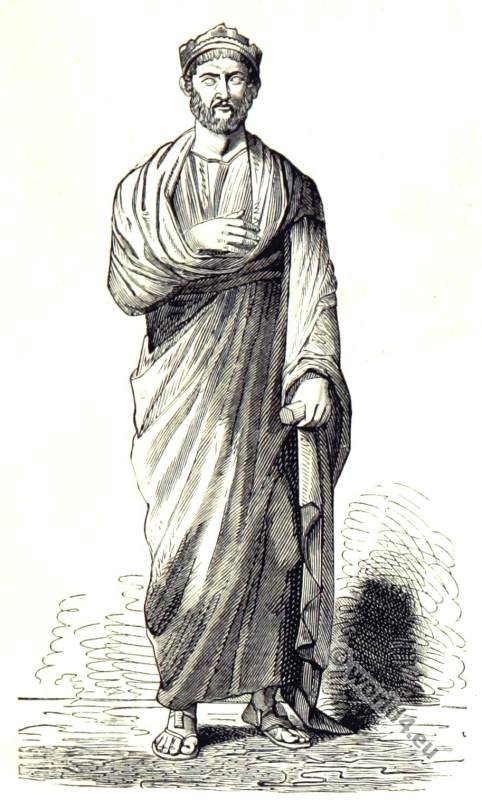BYZANTINE.

GREEK AND LATIN CLERGY. ASCETICS AND MONKS. THE BLESSING OF THE GREEK AND LATIN CLERGY. THE EMPEROR OF THE EAST ROMAN EMPIRE AND THE OFFICERS OF HIS RETINUE.
THE ROMAN CONSUL. THE PATRICIAN. SECULAR AND ECCLESIASTICAL UTENSILS. GREEK AND LATIN CLERGY.
No. 6th Greek bishop; 9th century.
Sticharium 1) decorated with two stripes or longitudinal stripes, the so-called clavi, reaching down to the feet. Phenolium, choral cloak without lateral slit. Omophorium (liturgical garment of the patriarchs) or pallium with lead plates at the lower edge so that it falls straight down.
1) (pleated tunic, linea sticharia, liturgical vestment. In the Latin Church called Albe)
- Nos. 16 and 18. Patriarchs of the same period.
In addition to the costume pieces mentioned above, the hypotrachelium, a stole made of gold fabric; the hypognatium, a kind of belt pouch. No. 16 has a superhumeral made of gold fabric instead of the pallium. - Nos. 18 and 19. Latin bishop and abbot.
- No. 13. Heldric, Abbot of Saint-Germain d’Auxerre.
No. 19. St. Marcus in episcopal vestments.
No. 17. French bishop; XI. Century. Conical tiara with metal ring and ball. Embroidered amictus, alba, dalmatica, casula with pallium. On the left arm the manipula, a linen cloth for cleaning the sacred vessels.
ASCETICS AND MONKS.
The Greek ascetics wore the pallium of the ancient philosophers, the tunic, a diadem-like headband, the oriental trousers, sarabella, and high boots of gilded leather.
Nos. 1, 2 and 3. Byzantine Saints. End of the 10th Century. Diadem-like headband; pallium; dalmatica and tunica embroidery; shoes made of gilded leather. No. 3 wears the superhumeral (rational) over the pallium.
THE BLESSINGS OF GREECE AND LATIN
The Greek blessing is given with the forefinger stretched out, the middle finger slightly curved, the thumb crossed over the ring finger, the little finger curved (nos. 6, 16, 18 and 19). Thus approximately the monogram of Christ is created. In the Latin blessing, the first three fingers are stretched out, the ring finger and little finger are closed. The first three fingers represent the Trinity, the other two the divine and human nature of Christ.
THE EMPEROR OF THE ROMAN EAST EMPIRE AND THE OFFICERS OF HIS RETINUE.
- No. 20 Nikephoros III Botaneiates (1002-1081), Emperor of the Eastern Empire; crowned 1078.
- No. 4, 5, 7 and 8. officers of the imperial entourage.
For the costume of the emperor see table Franconian-Byzantine No. 3. - The officers wear an embroidered cloak with a chest piece of gold fabric.
THE ROMAN CONSUL.
No. 14 Byzantine Consul of the Eastern Roman Empire; 5th century.
The attributes of the consul are the trabea or palmata, the gold-embroidered toga with the purple stripe and the subarmale profundum or lorum, a broad strip of fabric from which the pallium of the clergymen developed. In addition there were the calceis auratus, gilded boots.
The consul sits on the sella curulis, holding in one hand the sceptrum eburneum (an ivory sceptre as a mark of consular rank), in the other the mappa, at first a kind of cloth, then a roll which he threw into the arena as a sign at the beginning of the games. The figure of the consul is borrowed from an ivory diptych.
THE PATRICIAN.
No. 21. purple, gold embroidered toga over a dark tunic; sandals held by thin cords. The throne chair is covered by a cushion with embroidered stripes.
SECULAR AND ECCLESIASTICAL UTENSILS.
No. 12 and 22. armchairs from the beginning of the 10th century.
The miniatures of the manuscripts of the 9th, 10th and 11th century show only exceptionally armchairs with high backrests, and then they are always honorary seats for outstanding personalities.
No. 15th Phari, candlestick; 9th century.
The use of candles goes back to the time of the foundation of the Christian church. With the Latin people they were placed on the altar itself since the 10th century. The Orthodox placed them on a small side altar. They were also presented by lecturers and acolytes to the acting priest and deacon.
Nos. 1, 2, 3, 9, 10, 11, 16 and 18 after paintings on wood from Mount Athos, Greece, owned by the Didot company in Paris.
No. 4, 5, 7, 8 and 20 from the (Euvres choisies de saint Jean Chrysostome (Paris National Library ms. 79, fonds Coislin); after engravings which the Count de Bastard had made after the manuscript.
Nos. 6 and 15 from the Monuments français inédits by Willemin after a manuscript of the 10th century
Nos. 12, 13 and 22 from the Recueil des Costumes Français by Beaumier and Rathier, after the miniatures of a manuscript from the 10th century.
No. 14 from the Encyclopédie méthodique by Mongez.
No. 17 a statue from the portals of the cathedral in Chartres.
No. 19 from a Gospel book of the 11th century in the Abbey of Luxeuil.
No. 22 from a Gospel book of Charlemagne in the National Library in Paris.
C.F. Didron, Adolphe Napoleon, Christian Iconography. – Didron und Faul Durand, Manual of Greek and Latin Christian Iconography. – Martigny, Dictionary of Christian Antiquities, 1877.
Source: History of the costume in chronological development by Auguste Racinet. Edited by Adolf Rosenberg. Berlin 1888.
Related
Discover more from World4 Costume Culture History
Subscribe to get the latest posts sent to your email.






